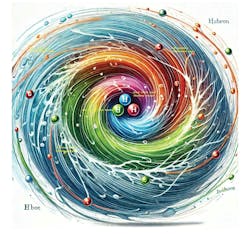Why this article is important
- This article takes a deep dive into the concept of mass, from atomic and molecular levels to subatomic particles, explaining how mass originates from the energy interactions of quarks, gluons and other particles.
- It explains atomic mass, isotopes and molar mass, including how molecular weights are determined using the Periodic Table.
- It gives a practical application of mass calculations in process automation, including converting mass flow (kg/s) into molecular flow using Avogadro’s number.
- It shares insights into how Coriolis meters determine mass flow by measuring fluid inertia and its deflection in a vibrating tube.
For years, I wrote about mass flow, volumetric flow and mass flowmeters. Yet, I struggled to understand mass. I understand the word and know how to use it, but I don’t feel that I really understand mass flow. Likewise, I struggled to understand the theory behind Coriolis and thermal flowmeters. My last two columns were steps towards defining mass. Here, I look at atomic mass and the mass of molecules and provide a definition of mass.
Atomic mass
My previous columns drilled down to get to the most elemental concept of mass. If we now build back up, we can say that much of the mass of protons and neutrons derives from the near-lightspeed movement of the high-speed quarks. The mass of an atom derives from its nucleus, which is made up of protons and neutrons. The more protons and neutrons in an atom, the more mass. By referring to the Periodic Table of Elements, we can determine how many protons are in a mass. This is its atomic number. For example, hydrogen has only one proton and its atomic number is 1. The Periodic Table is ordered according to the atomic number of elements in the chart. Carbon, with an atomic number of 6, appears to the right of hydrogen, while oxygen, with an atomic number of 8, appears to the right of carbon.
While the number of protons in an atom remains constant for the type of element it is, different atoms of the same element can have different numbers of neutrons. For example, Carbon-12 has six protons and six neutrons, while Carbon-14 has six protons and eight neutrons. A proton’s mass number represents how many protons and neutrons atoms of this type have. The mass number of Carbon-12 is 12; it has six protons and six neutrons. The mass number of Carbon-14 is 14; it has six protons and eight neutrons. These different variations of carbon atoms are called isotopes. Like carbon, other atoms also have different isotopes.
The Periodic Table also contains the atomic mass of each element. The atomic mass of each element is the weighted average of the masses of all the isotopes of an element, taking their natural abundance into account. The isotopes of an element have different atomic masses because they have different numbers of neutrons.
Mass of molecules
Atoms combine to form molecules. The mass of a molecule is the sum of the masses of the atoms it contains. For example, water has the formula H2O. This means that one molecule of water contains two hydrogen atoms and one oxygen atom. We can derive the mass of one molecule of water by summing up the masses of two hydrogen atoms and one oxygen atom. However, now that we know about isotopes, we know that the molecular weight of molecules may vary, depending on the component isotopes. In fact, oxygen has three stable isotopes, along with several short-lived ones. The atomic mass value for oxygen in the Periodic Table takes these isotopes into account. By for the most common oxygen isotope is Oxygen-16.
While atomic mass represents the mass of atoms, the mass of molecules is called molar mass. The unit of measurement for molar mass is g/mol, meaning grams per mole. A mole is a unit that represents 6.022 x 1023 particles (atoms, molecules, ions, etc.). This number is called Avogadro’s number. This is a huge but important number because it helps us bridge the gap between the molecular world and the objective world of our experience.
What is the mass of one molecule of water? We calculate it by using the atomic mass of hydrogen and the atomic mass of oxygen. A molecule of water has two hydrogen atoms and one oxygen atom. Using the Periodic Table, we find that the atomic mass of hydrogen is 1.008. The atomic mass of oxygen is 15.999. Therefore, we can compute the atomic mass of one molecule of water using the following formula:
(Atomic mass of hydrogen x 2) + the atomic mass of oxygen
The works out to be the following formula:
Hydrogen (H) g/mol = 1.008 x 2 = 2.016 g/mol
Oxygen (O) g/mol = 15.999 g/mol
Total molar mass of H2O = 18.015 g/mol
When calculating molar mass, the general practice is to use the atomic weights listed in the Periodic Table and not worry about molecules containing particular or different isotopes. Of course, if a particular molecule contains a unique isotope, the molar mass could be calculated by using the atomic mass of that isotope rather than the atomic mass listed in the Periodic Table.
Mass of water
What is the cash value of knowing the molar mass of water? The SI unit for mass flow measurement is kilograms/second. This gives us a way to work down from a mass flow measurement in kilograms per second to the number of molecules being measured. It can be done using the following steps:
1. Convert kilograms/second to grams per second. 1 kg = 1000 grams. If the mass flowrate is 0.25 kilograms/second, convert this to 250 grams/second.
2. Convert grams to moles, using the molar mass of water:
Moles per second = (250 g/sec)/(18.015 g/mol) = 13.877 mol/s
3. Convert moles to molecules, using Avogadro’s number:
13.877 mol/s = 6.022 x 1023 = 8.36 x 1024 molecules/s
What is mass?
The above demonstration shows that we can convert any mass flow measurement of water in kilograms per second into a measurement of the number of molecules flowing in a unit time. This can be done for any fluid, provided we know the molar mass. What are the implications for the definition of mass?
Previous discussion showed that the mass of molecules amounts to the mass of the atoms making up those molecules. Looking at the Periodic Table shows that, among the 118 elements, there is a wide range of atomic mass values. These values are determined by the number of protons and neutrons contained in the nucleus of the atoms. Heavier atoms have more protons and neutrons, while the lightest one, hydrogen, has only one proton. Electrons and binding energy play only a very small role in the mass of an atom.
Get your subscription to Control's tri-weekly newsletter.
Previously, we discovered that protons and neutrons are made up of even smaller particles called quarks. However, the mass of the quarks only accounts for about 1% of the mass of the proton. Most of the proton’s mass arises from the interaction between the quarks, gluons, and other particles that are held together by the strong nuclear force. These particles moving at incredible speeds and the energy they generate are the ultimate source of mass in protons and neutrons. The ultimate source of mass is energy.
How does this impact our understanding of mass and the previous discussion? The energy of the subatomic particles inside a proton generate the mass of the proton. It has tremendous energy inside it from the interaction of quarks, gluons, and other particles, all of which are held together by the strong nuclear force. Yet the proton doesn’t have a specific boundary or “skin” holding this all in—the internal particles are prevented from “flying out” and are held in place by the strong force that binds them together. This explains why protons, atoms, and even molecules can move at relatively slow paces compared to the near light-speed of the subatomic particles within the proton. Despite all the incredible energy inside the proton, it has a not-well-defined boundary that keeps it together as an entity.
In many respects, a proton is like a hurricane. A hurricane is held together by its eye, its eyewall, and by the rainbands of clouds and thunderstorms that spiral outward from the eyewall. Like the proton, a hurricane isn’t enclosed in a physical boundary. Instead, the edge of a hurricane is marked by the area where the winds fall below hurricane force and the violent storms that are part of the hurricane dissipate. The above illustration shows the proton as a hurricane-like structure.
Mass defined
What is mass? In a previous column I cited the Cambridge English dictionary definition of mass as “the amount of matter in any solid object or in any liquid or gas.” We can now define mass as:
From the scientific point of view, mass is the amount of matter in a solid, liquid or gas, where the matter is a field of energy created by the interactions of quarks, gluons and other subatomic particles moving at near-lightspeed and colliding with each other. These subatomic particles are contained in the proton or neutron of an atom. The amount of matter in a substance is proportional to the number of protons and neutrons in the substance, which determines its atomic and molecular structure. The speed with which atoms and molecules move creates an emergent and objective world of matter that we experience as objects in solid, liquid, or gas form.
From an objective (experiential) point of view, mass is inertial mass, and it quantifies the resistance of an object to changes in motion. This resistance to change in motion in a solid, liquid, or gas is created by its atomic and molecular structure. The amount of resistance to change is proportional to the number of protons and neutrons in the structure. Ultimately, the amount of resistance to change is determined by the strength of the field of energy created by the subatomic particles in the structure.
Conclusion
The demonstration of the way to work down from the unit of mass flow, kilograms/second, to the number of molecules being measured shows a bridge between mass flow as we experience it and the scientific world of molecules and atoms. When we measure mass flow in a fluid, we are measuring its resistance to flow as determined by its molecular structure. Coriolis meters determine mass flow by measuring how much a vibrating tube is deflected by the inertia of fluid. The force or momentum of the fluid is proportional to its mass, and this determines the amount of deflection, giving us mass flow.
About the Author

Jesse Yoder
Columnist
Jesse Yoder is founder and president of Flow Research Inc., which conducts market research studies in a wide variety of areas, including the flowmeter market.

Leaders relevant to this article:
